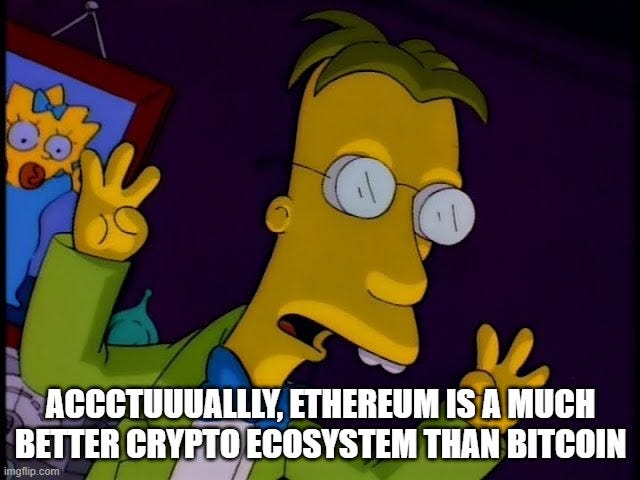Cryptocurrency is neat but overhyped (Pt. 1)
Bitcoin Bitcoin Bitcoin Bitcoin Bitcoin
This would’ve been a lot more interesting if I wrote it in early February 2022. Back then, you would’ve just seen a flurry of high-profile advertising around the Super Bowl, with celebrities, cryptocurrency advocates, and investors basically saying, “Buy Bitcoin. It’s the future! If you miss out, you’re dumb.”
At the time, if you questioned their reasoning, you were probably mocked and then decided to ignore the whole thing. And yet, despite a pretty serious crash, crypto is still chugging along and the value of digital tokens (that may or may not serve a useful purpose) have rebounded somewhat.
In part one of this two-part post, I’ll talk about why crypto generated interest. Part two will explore why it hasn’t done more of substance to improve the economy.
Blockchain is cool I guess…
OK, so how does this stuff even work? A better way to start is to think about why it was created in the first place.
Before Ticketmaster (ugh, more on them later) had an organized secondary ticket-selling market, I had a digital concert ticket for an event I later realized I couldn’t attend. I went on eBay and advertised what I had. A kind, trusting soul bought the ticket and I sent them the PDF file with the barcode needed for entry to the show.
I could’ve easily scammed this person and gone to the show myself or given it to a friend. I was able to send them the electronic ticket file, but we both had the same copy of the ticket. Whomever got to the ticket entry gate first would be the winner. There was nothing to definitively show to the concert venue security staff that the eBay buyer was now the rightful owner of the ticket and not me. Thankfully, I’m a trustworthy person and I’d received enough good feedback from other eBay transactions to signify that I would act honorably.
Recognizing this issue, TL;DR a person(s) writing under the name Satoshi Nakamoto published a paper in 2008 with a solution to the “double-spending problem”: Bitcoin! Before 2008 people were still able to digitally send things to each other. But you couldn’t transfer ownership so easily.
Bitcoin and other cryptocurrencies bypass this problem with blockchain technology. Normally, if I want to give you a dollar, I do it in person with cash or I need the help of an intermediary. Banks and credit card companies facilitate the swap, ensuring the right amount of money moves to the appropriate account.
Blockchain has the potential to take the traditional financial intermediary out of the equation. It’s like a big, shared database where everyone who participates can see what’s going on and approve valid transactions with [computer stuff]. This peer-to-peer network works because people who follow the rules and approve good transactions and reject nefarious ones get rewards for their effort.
Here is why that’s neat. I’m not aware of anyone that loves Ticketmaster. The fees are INSANELY high and there isn’t much you can do about it, since almost every major venue and entertainment franchise uses their platform.
Instead of giving Ticketmaster large sums of money to handle sales and distribute tickets with certified, legitimate bar codes, a sports franchise could use a blockchain solution to distribute tickets directly and save us all the headache. Huzzah!
They probably won’t, for reasons I’ll explore in part two. But this is one of the potential applications of blockchain technology that would be worth pursuing.
There are others. Sending money to someone in another country is not easy; instead of navigating one country’s laws, you’re dealing with two sets of laws. And those countries might not play well together. A company called Ripple uses blockchain to offer an easier option for banks and other large financial firms. And this idea of decentralization sounds like an opportunity to spread the wealth a bit and give the little guy a chance.
However, there are some, uh, downsides to all this.
If you think climate change is real…
It turns out that Bitcoin can be a tad inefficient. Doing things peer-to-peer does have its benefits, but the amount of electricity it uses to do things is ridiculous.
When climate activists say that Bitcoin uses more electricity than many medium-sized countries, they aren’t kidding. Like most cryptocurrencies, Bitcoin is “mined.” New tokens are made by (simplification alert) people who buy a whole bunch of computers and use all that computing power to run through a bunch of numbers to guess the magic word of the day, and then poof, a Bitcoin appears.
While I don’t love Ticketmaster, I don’t want to use more electricity to buy a ticket to a concert than I do to stream an entire movie.
There is some good news on this front. Other cryptocurrencies/blockchain protocols, like Ethereum, use a different way to issue new tokens and validate transactions. Instead of needing a room full of computers, you “stake” your crypto token to the network. You temporarily give up control of your token(s) and then get a chance to approve valid transactions and trades to receive rewards. At least that’s more energy efficient, I suppose. The fees, on the other hand… (More on this next time)
Then things changed
So it’s a mixed bag. Crypto is certainly interesting and worth experimentation. But as things scale up, dealing with energy efficiency and keeping transaction fees down becomes more challenging. What really hurt the crypto effort, though, is its focus. What do consumers actually want and how do these new ideas jibe with those preferences?
Despite what’s above, as people began trying out Bitcoin and its value surged, it’s price versus the US dollar became the primary driver of interest. In the early days, you could have a smart conversation about crypto, usually with at least one person in the room pointing out that blockchain, not the Bitcoin tokens themselves, held the real opportunity. Unfortunately, those voices got drowned out by the evangelists and the marketing teams. We’ll leave things here and talk about the struggles in part two.



